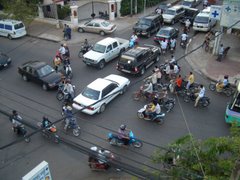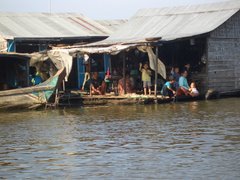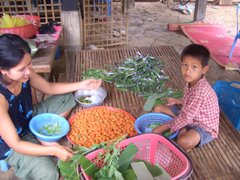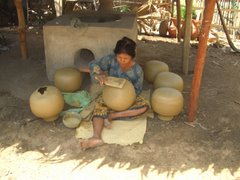Sitting at Flavours on the corner of Rue 51 and Rue 278 for breakfast one morning not long ago, I thought I heard a marching band, in the middle of the week. You know, a good old marching band with drums and horns and all the trimmings. No way, I thought. Then there it was again, the faint but distinguishable sound of a marching band.
I strained my eyes toward the end of the street and began to notice a couple of official vehicles with their emergency lights flashing. Then the majorettes and flag bearers, and finally the band. I could have been in the middle of Pensacola, Pittsburgh, perhaps even Poughkeepsie – but not Phnom Penh. It was a complete Western-outfitted marching band like they’d come straight from the heartland of America.
And then there were floats. Three of them to be exact. The front and rear floats had what looked like huge green cans of Raid insect spray, each about 10 feet tall. I thought, “Hmmm, I guess Raid is sponsoring this parade - how odd.” The middle float had a number of children clad in lime green raid tee shirts and a crowned queen – I suppose she was the Raid Queen of Cambodia. A colossal honor for a young Cambodian girl, I suppose.
But then after the floats came hundreds of children, during the middle of a school day no less, all clad in Raid lime green t’s. Then a few hundred more, followed by a few hundred more. It was unreal. Something big was up.
So I asked my waitress what was going on (actually I just pointed and gestured, using a few pidgin English words to try and communicate with a non-English speaker) and she simply said one word: dengue.
Dengue is a word that strikes fear into the hearts of families with young Khmer children because if left untreated - or poorly treated – it can be deadly. Otherwise known as “break-bone” fever, dengue is transmitted by mosquitoes, similar to malaria, but there is no vaccine against it. There are several forms of dengue, but the most serious form is hemorrhagic dengue. One of my fellow volunteers came down with this form of the disease and had to go to Bangkok for treatment.
So, like malaria, people of the west rarely hear about diseases that ravage children. Several hundred have died here in Cambodia this year, with tens of thousands contracting it this year alone. It is at epidemic proportions this year and it seems to recur every five years or so in SE Asia. With proper medical attention the mortality rate should be very, very low. Not so in Cambodia where the health care system is abysmal – so much so that if any of our volunteers get really sick they get on a plane and head for Bangkok, about an hour away from Phnom Penh.
The availability and quality of medical treatment here is directly related to the inhumane and torturous years of the Khmer Rouge. Democratic Kampuchea may have only lasted less than four years from April 1975 to January 1979, but the utter decimation of civil society rendered nearly all institutions essentially null, including healthcare. Because the Khmer Rouge rejected anything Western, all doctors and medical personnel either were forced to flee the country or were killed. The same fate was met by all formally educated Cambodians who were thought to be polluted by Western thought. Pol Pot wanted Democratic Kampuchea to be rebuilt on an extreme communist platform, Mao Tse Tung style, and to devolve the country into a pre-industrial agrarian society. Two million people lost their lives in this failed communist experiment – nearly one fourth of all Cambodians. (Finally, nearly 30 years later, it appears the trials of Khmer Rouge leaders are actually going to come off.)
So these kids in green shirts were marching to create awareness amongst Khmer families. Buying a can of Raid and spraying it in one's home to kill mosquitoes is one method. Having the government provide mosquito control would be another, but they seem to be too busy with other things. An epidemic is underway, but no action, no acknowledgement of a problem since November 2006 when it started, nothing. Dr. Beat Richner, an outspoken doctor, has been referring to this (and other ignored diseases) as the “passive genocide of children”.
Nearly 20% of Cambodian children don’t reach their 18th birthday. They suffer from a toxic range of threats that children in Western or developed countries simply don’t face, not in large numbers at least. Personally, I was shocked at the huge outcry of support for the young English child, Madeleine, who was abducted in Portugal recently. She is just one of a number of Western poster children who symbolize the high value we place on a Western child’s life. But what about the two to three million children that die each year from preventable diseases such as malaria? Where is the public outcry and outrage over that?
It starts with awareness, and it continues with action. If you'd like to help, one small act you can do that has impact is to support the mosquito net program sponsored by the Cambodia Daily, the local Phnom Penh newspaper. Each $5 contributed buys a mosquito net that provides protection for three family members and will be distributed for free to the most in need Cambodians. Although dengue is the current major threat, malaria is still Cambodia’s most deadly disease. Click here if you’d like to find out how to contribute. 100% of the money goes directly toward buying mosquito nets.
And don't worry about me - I take mosquito borne illnesses seriously. The DEET people are doing very well off of me for these six months.
Friday, July 20, 2007
Subscribe to:
Post Comments (Atom)











No comments:
Post a Comment